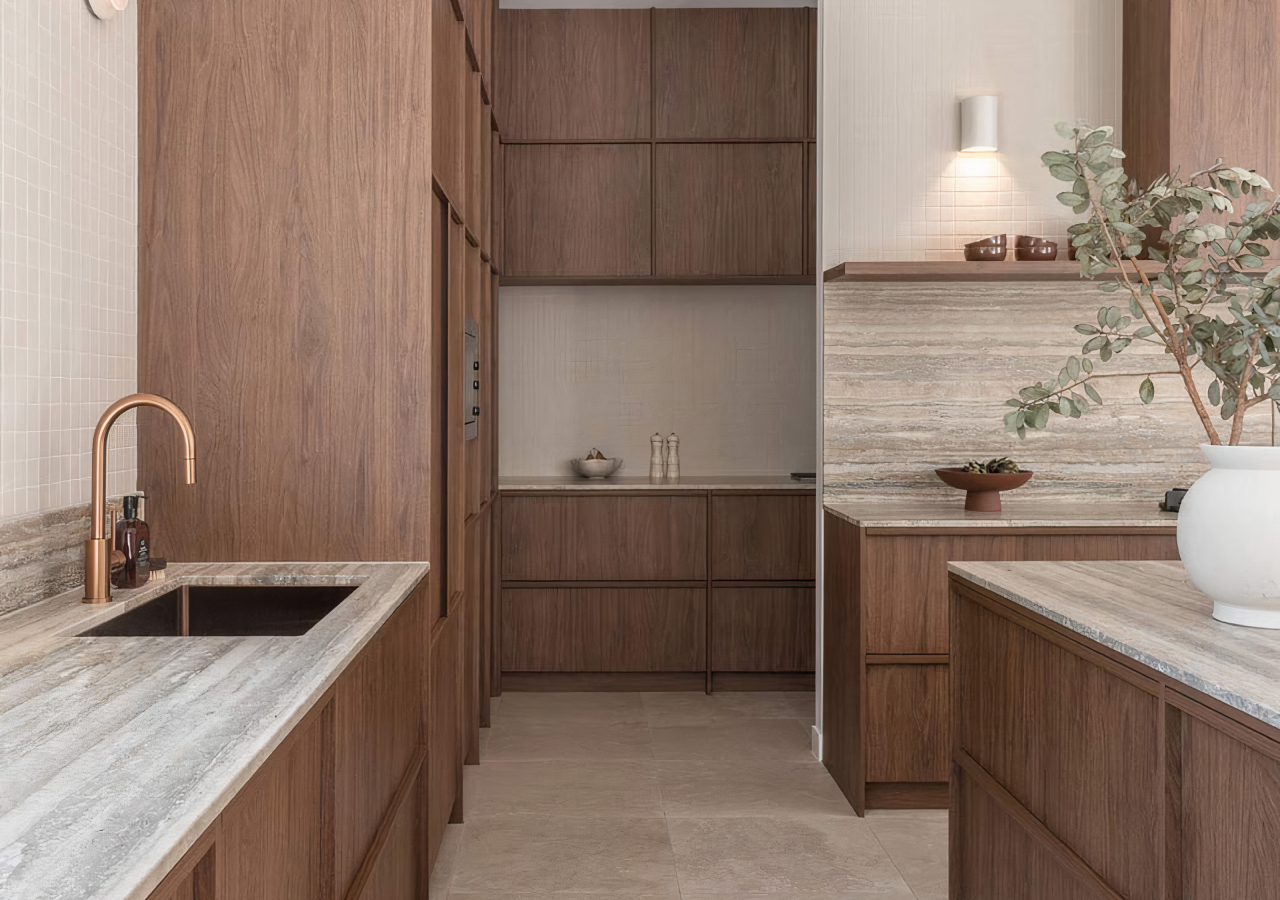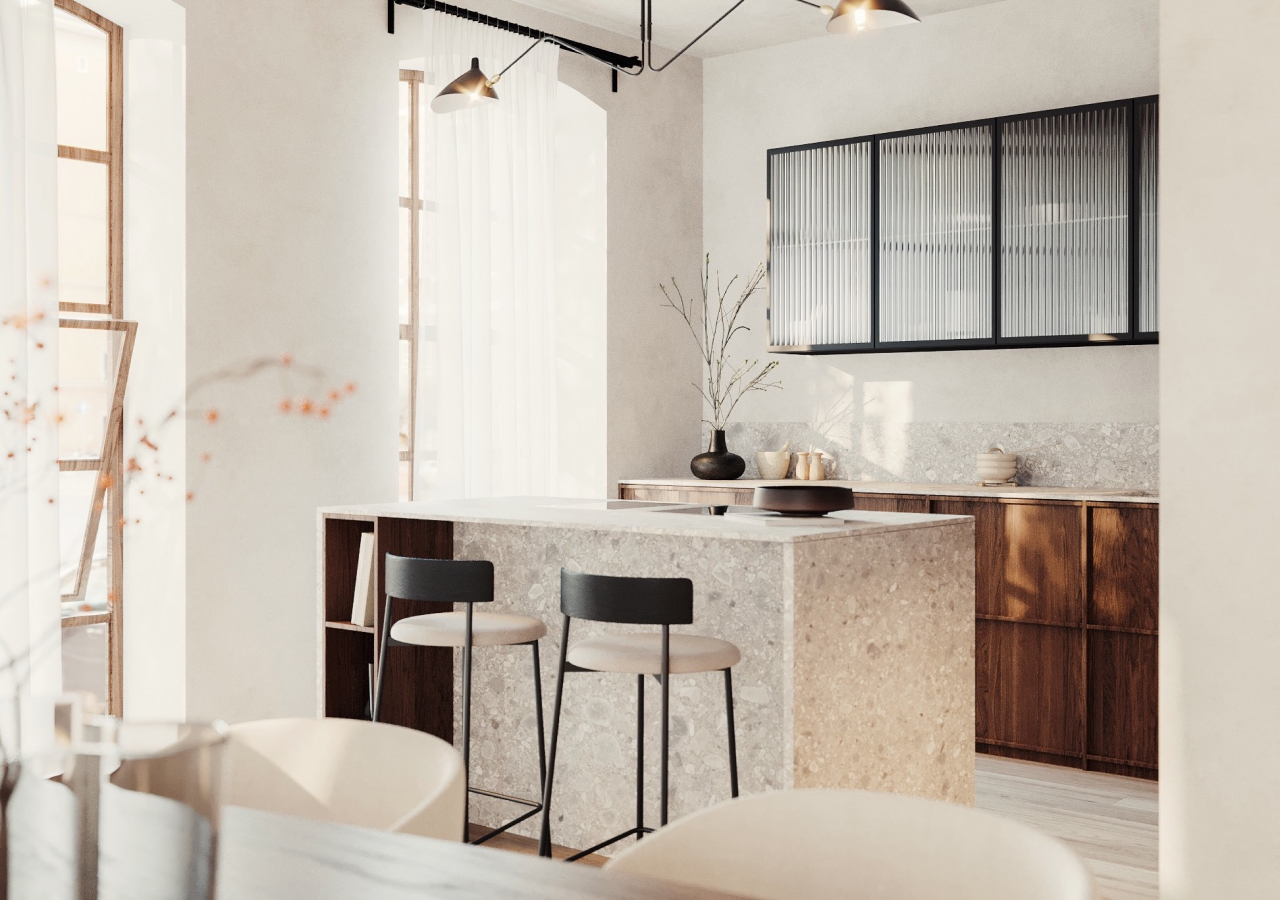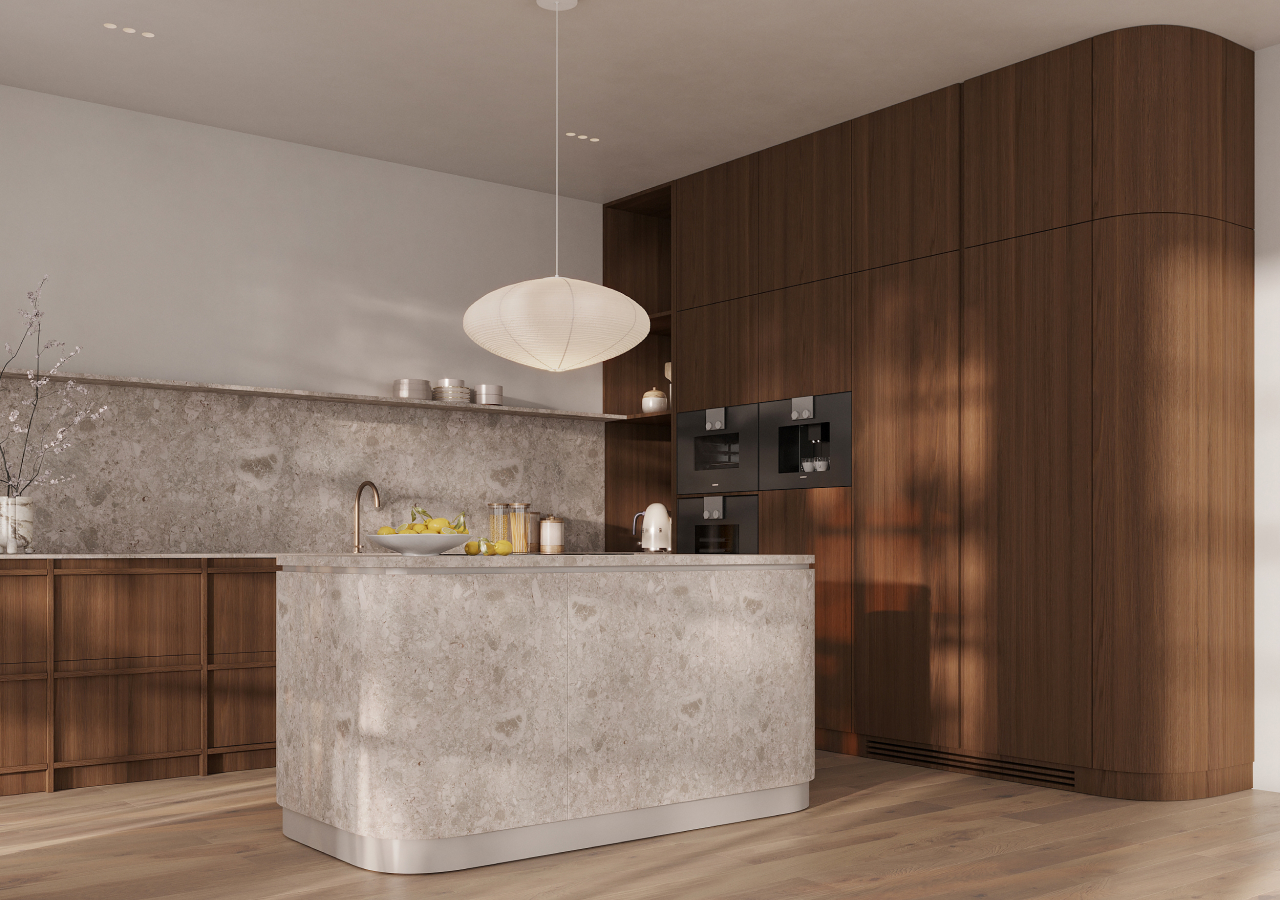The Japandi kitchen combines the philosophy of calmness, mindfulness, and simplicity with Japanese sophistication and Scandinavian coziness. It creates a space where minimalism harmonizes with warmth, and every detail matters.
Materials, shapes, and light can achieve the balance and the look of the Japandi style. Natural textures, soft colors, and thoughtful proportions create an atmosphere of harmony and comfort where beauty and functionality coexist. In this article, we will explore the key principles, materials, and stylistic accents that will give your kitchen the warmth and understated elegance of the Japandi kitchen design.
Understanding the Principles of Japandi Design

Modern Japandi design is built on balance: light and shadow, function and beauty, restraint and warmth. The result is a kitchen that feels calm, intentional, and deeply connected to nature.
Intentional simplicity
The main principle of Japandi style is the absence of excess. Minimalist layouts, free surfaces, and open areas create a feeling of lightness and transparency. There is no place for visual noise here, only truly important objects that bring joy.
Natural materials
Warm wood, ceramics with a lively texture, stone, and matte surfaces fill the interior with tactility and natural energy. These materials create a balance between strength and softness, giving the kitchen a feeling of comfort and stability.
Calm color palette
The color scheme is based on natural, balanced tones: shades of ivory, sand, gray-beige, and smoky gray. Graphite, charcoal, or deep brown accents are used for contrast, adding depth to the interior without disturbing the calm.
Exquisite details
Even the simplest elements in modern Japandi kitchen are filled with elegance. Soft curves, refined shapes, and textures that reveal the hand of the craftsman create an impression of thoughtful perfection. Attention to detail makes the interior cohesive and harmonious.
Design with intention
Japandi is a style in which every element has meaning. Here, not only the visual component is valued, but also the sensation: how an object sounds in space, how it reflects light, and how it affects the mood. This approach transforms the kitchen into a place where you want to be, cook, live, and relax.
Choosing a Neutral Color Palette

In a Japandi-style kitchen, tranquility begins with color palette. A carefully selected palette sets the mood for the entire space, helping to create an atmosphere of balance, cleanliness, and comfort.
Start with a soothing base
The interior is based on soft neutral tones: cream white, warm gray-brown, and misty gray. They create a calm background that allows the texture of wood, natural materials, and finishing details to stand out without distracting from the overall harmony.
Shades inspired by nature
To make your kitchen more cozy and “lively,” turn to colors found in nature. The tones of raw linen, light oak, or muted clay add warmth and naturalness to the interior. This palette connects the space with organic materials characteristic of Japanese and Scandinavian traditions, creating a feeling of comfort and familiarity.
Let light define the space
In Japandi kitchen design, light plays just as important a role as color. Neutral shades gently reflect it, filling the room with air and a feeling of space. Light, gliding freely across walls, cabinets, and work surfaces, makes the kitchen feel light, open, and balanced.
Contrast with intention
Although the Japandi style is based on softness and nuance, contrast also has its place here. Subtle accents—such as matte black or charcoal gray in decorative elements, lighting fixtures, or furniture—add depth and visual structure to the space without disrupting the overall harmony.
Creating a cohesive look
The ideal Japandi kitchen palette does not seek to stand out; it sounds like a single whole. Shades, finishes, and textures should complement each other, creating a sense of balance and timelessness. In such a kitchen, each element fits naturally into the composition, transforming the space into something more than just a place to cook.
Bring Nature Into Your Interior with Greenery

Plants are essential to Japandi kitchen interiors. They add life, soften lines, and connect the space to the natural world. They are not just decoration but a reminder of the tranquility that comes from simplicity.
Plants with benefits
Choose greenery that not only decorates but also serves a purpose. Potted herbs—rosemary, basil, and mint—add aroma and functionality to the kitchen. Placed on open shelves or near the work area, they emphasize the purpose of the space and add coziness without feeling cluttered.
Aesthetics in the details
Pots and vases should support the aesthetics of Japandi design: soft shapes, matte surfaces, and muted tones. Earthy-toned ceramics or stone-textured vessels add naturalness and maintain the visual rhythm of the interior.
Bring in organic elements
A little carelessness only enhances the space. Let a single hanging green branch, a sculptural composition of twigs, or a simple ikebana create a lively contrast to the clean lines of the furniture. These moments of softness add depth and naturalness to the interior.
Frame the outside world
Use window sills and natural lighting to bring nature inside. Plants placed in streams of daylight change throughout the day, adding dynamism and liveliness to the interior. Greenery becomes part of the rhythm of the space, unobtrusive but meaningful.
Balance of stillness and life
A Japandi-style kitchen brings balance to static forms with lively accents. Even a single plant, placed with care, can change the atmosphere, reminding us that true harmony is born from the union of simplicity and naturalness.
Balance Between Minimalism and Comfort

The Japandi kitchen strikes a harmony between order and warmth. With hidden storage, natural textures, and warm lighting, it is a serene yet livable space. Here, every item has meaning; every detail is meaningful. Such an interior requires discipline and intuition to keep the space simple yet lively and cozy.
Optimization for visual clarity
The main goal is to create a visually calm space. Kitchen cabinets with clean lines, smooth countertops, and an open layout help avoid a feeling of clutter. Everything is thought out to the smallest detail: storage space is hidden, shapes are concise, and attention is focused on balance and clarity.
Natural warmth in minimalism
Minimalism in modern Japandi kitchen is not synonymous with coldness. On the contrary, it is in simplicity that coziness is revealed. Warm wood, untreated stone, and woven or knitted textures add depth and softness, bringing the space to life. These materials give the interior a soulful feel without compromising its purity and simplicity.
Refined neutral palette
The calmness of a Japandi kitchen comes from subtle shades. Use combinations of soft neutrals—warm sand, smoky gray, and delicate sage. Light transitions between them and a variety of textures create a feeling of richness without visual clutter. Such a palette does not distract but envelops, inviting peace.
Conscious display
Open shelves in Japandi design kitchen are not for displaying collections but for breathing space. Only a few meaningful items should be placed on them: handmade ceramics, wooden bowls, and simple vases. These items add personality and emphasize the philosophy of the style: beauty in simplicity and conscious choice.
Light as a design tool
Lighting plays a key role in balancing austerity and comfort. Use as much natural light as possible, and for evening lighting, choose pendant lamps or sconces with soft, diffused light. The interplay of light and shadow creates subtle drama, emphasizes textures, and adds warmth to the space.
The power of details
There is no room for random elements in a Japandi kitchen; even the smallest details matter. Metallic accents in warm matte tones, smooth shapes, and tactile surfaces become quiet but expressive touches. They combine Japanese sophistication and Scandinavian functionality, creating an interior where austerity coexists with softness and simplicity with a sense of home.
Inspiring Scandinavian Coziness: Hygge
.webp)
The secret to creating a truly cozy Japandi-style kitchen lies in soft, almost invisible warmth. It is light that gently glides over wooden surfaces, matte facades, and ceramic details. “Hygge” brings warmth to Japandi minimalism through textures, light, and comfort. It turns functional kitchens into spaces of quiet joy.
Combined with Japanese restraint, it reveals the soft side of minimalism, where comfort is not opposed to simplicity but born from it.
Start with a soothing color scheme
To convey the atmosphere of hygge in a Japandi kitchen, use a soft, neutral palette. Shades of oatmeal, chalk gray, and warm gray-brown reflect daylight and create a foundation on which the textures of wood and natural materials can be revealed. This palette promotes calm and harmony, allowing the interior to “breathe.”
Give preference to organic materials
Natural materials are the basis of comfort and durability. Light oak wood shelves, handmade ceramics, and linen textures add authenticity and warmth to the interior. These elements connect the space with nature, creating a sense of sustainability and tactile pleasure.
Let texture set the tone
Texture in Japandi kitchen design is a way to add depth without unnecessary details. Woven baskets, wool or linen cushions, and handmade ceramic cups create a feeling of lively warmth. Each item brings its own rhythm, forming visual richness without overload.
Edit with intention
The main rule is “less is more.” Remove everything unnecessary, leaving only meaningful accents. A single expressive element, whether it's a matte brass faucet or a laconic sculptural detail, can become the center of attention. When choosing items, be guided by durability, quality, and understated aesthetics; this is the true luxury of the Japandi style.
Nature as part of the interior
Living greenery gently softens strict lines and adds life to the space. Small plants—herbs, climbing shoots, or simple compositions in stone vessels—bring a sense of movement and tranquility. They are not accents but a natural continuation of the style's philosophy, where everything lives in balance.
Light that creates atmosphere
Lighting in Japandi kitchen is a tool for setting the mood. It should be multi-layered: functional LEDs under cabinets are combined with soft pendant lights that create a cozy atmosphere. The light here is not dazzling—it emphasizes the texture of the wood, the warmth of the tones, and the tranquility of the space.
A space you want to live in
The fusion of hygge and Japandi style creates an interior where comfort is not ostentatious but profound. Such a kitchen meets practical needs, and at the same time becomes a place for relaxation, restoration, and contemplation. Here, every element is well thought out, and every detail serves one purpose—to create a home where it is pleasant to be.
Completing the Look of a Japandi-Style Kitchen

When designing a Japandi-style kitchen, every detail matters. The interplay of laconic minimalism and natural warmth creates the foundation, but it is the small details that determine the character of the space. The thoughtful shape of a handle, the texture of a surface, the play of light on metal or wood—all of this transforms functional elements into expressive accents.
True harmony is born at the intersection of design and functionality. Nothing in a Japandi kitchen interior is accidental: every item must be pleasant to the touch, reliable, and aesthetically balanced. Tactile materials—matte metal, brushed brass, smooth wood—add depth and a sense of calm to the space.
When creating a Japandi kitchen design, it is important to remember that balance is not only visual purity but also emotional equilibrium. The space should evoke a sense of peace, where form, function, and atmosphere exist in unity. Such a kitchen becomes more than just a place for cooking, but a refuge for the mind and senses. It becomes a place where aesthetics meet mindfulness, and every detail has its purpose.





